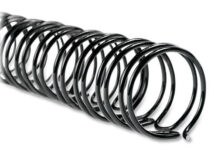by Brian Cowie, CEO, The Paper Mill Store

Will you fold, score and bind your paper, or will you crush, break and warp your paper? That is the question.
Proper folding, scoring and binding of paper are mostly a matter of understanding the major properties of paper fiber. One of the most important properties to understand about paper fiber is grain direction – the direction in which the fibers align on a specific sheet of paper. Yes, that pesky little grain direction issue – which is stated in so many swatch books, printing guides and all over paper mill literature – really means something and should be understood by everyone from graphic designers, printers, finishers and binders to home hobbyists. When working with paper, it is vital to know which way the grain flows.
Grain direction unraveled
A quick “Paper 101” on grain direction.
As paper is made, all the fibers within the pulp stew begin to line up in the direction in which the paper machine is moving. The cellulose fibers align, side by side, much like logs floating down a river during turn-of-the-century logging. The end result is that many more fibers than not are pointed in the same direction along a sheet of paper, forming a “grain direction.”
Typically, when using an 8.5×11-inch sheet of paper, the grain is in the 11-inch, or the “grain long,” direction, meaning that the vast majority of fibers are aligned parallel to the 11-inch length of the paper. In contrast, if the sheet was cut “grain short,” then most of the fibers would be pointing across the short side of the sheet in the 8.5-inch direction, or what is called the “grain short” direction.
Now you know
Paper has a grain direction. So, what? We all have our issues, right? Now hold on; it’s not that easy. Grain direction is very important and makes a huge difference as to how the paper will react when attempting to fold, score and bind it. Therefore, knowing the grain direction and how it will affect the layout of a project makes a big difference in the quality of the finished piece. A few minutes spent learning about and understanding grain direction will help for years to come.
Folding and scoring with the grain direction
Knowing why grain direction is important will be helpful as well. As a visual aid to the grain direction concept, think of paper fibers as a dozen wooden pencils lying side by side on a table, forming an imaginary sheet of paper. If this imaginary sheet of paper were to be folded, it can easily be imagined that folding in the parallel direction to the pencils is easiest. Fold across the parallel direction of the pencils, and the pencils will all snap in two.
While it is not exactly the same in paper as with pencils, the concept does illustrate that the best way to fold and score paper is with the grain direction parallel to your fold and score. Folding and scoring parallel to the grain will break fewer fibers and have a stronger and cleaner fold or score.
This can easily be demonstrated by taking a light cover stock, perhaps a 65 lb. cover, and folding it the length of the sheet and then folding it the width of the sheet. Examine both folds, and it can be seen that one fold is decisively cleaner and smoother than the other. The cleaner, smoother fold is parallel to the grain, and this illustrates how the paper fibers react more favorably when folded in the parallel direction.
Binding with the grain direction
Binding with the grain direction is very important for all methods of binding. Whether doing a simple saddlestitch or a more complex perfect binding, binding parallel to the grain is vital. The reason that grain direction is so important to successful binding is different from when folding and scoring; it is not a matter of breaking fibers. It is a matter of how paper fibers expand and contract in the open air. While this is a much less understood concept in the industry, it is an extremely important one to understand to avoid disastrous binding episodes.
Paper fibers constantly expand and contract, mainly due to ambient conditions as well as glues and moisture associated with many binding processes. Most likely, the expansion and contraction of unbound paper won’t be seen or noticed, but it is happening. Paper fibers expand and contract as much as 400 percent more across the grain direction of the paper fiber than with the grain direction.
This means that if paper is bound into the spine across its grain direction, as the paper expands and contracts, there will be as much as 400 percent more movement of the paper fighting against the anchor of the binding. This can result in very unpleasant consequences, including gusseting of the spine of the finished piece. Gusseting is the extreme warping of the spine due to the expansion and/or contraction of the bound paper. There is almost no way to repair a gusseted book once it is bound, but this issue can be avoided by using proper binding techniques.
When trying to visualize what happens in gusseting, imagine a pair of hands making a “time-out” sign – the fingertips of the right hand pressing into the palm of the left hand. The fingertips of the right hand represent paper fibers bound perpendicular to the spine of the book, which is represented by the left palm. Now, imagine the right-hand fingers spreading representing the paper fibers expanding. The right-hand fingers move across the left palm, which represents the spine as it stays stable. What results, in this scenario, is severe warping of the sheets as they try to move within the bound spine. The strength paper has to pull a spine into funky shapes with just the small expansion and contraction movements of cross direction paper fibers is amazing.
How to determine the grain direction

The easiest and best way to determine the grain direction of paper is to order it in the direction required, whether grain short or grain long. Grain direction is noted on most paper packaging, swatch books and paper mill stock sheets in one of a few different formats. Most commonly, grain direction will be noted as the last dimension of the sheet.
As an example, 11×17-inch would be grain long (fibers run in the 17-inch direction), 17×11-inch would be grain short (fibers run in the 11-inch direction). Sometimes the side of the sheet with the grain direction is bolded, so 11x17-inch would be grain long or 11x17-inch would be grain short. The grain direction may be underlined, 11×17-inch would be grain long, or 11×17-inch would be grain short.
Often there will be multiple indications of the grain direction on the label of a ream of paper. Whichever format is used, paper mills make a big effort to indicate the grain direction of every sheet of paper.
There are few things worse than experiencing an avoidable problem. By paying attention to grain direction, it is possible to avoid some of the all too common production errors that occur due to incorrectly formatting projects with respect to paper’s grain direction.
Professionals and hobbyists alike have trusted The Paper Mill Store, www.thepapermillstore.com, since 2004 to provide great papers at great prices. Thousands of brand-name papers, envelopes, card stocks, swatch books, samples and other products are available with an array of custom services including paper cutting, perforating, scoring, drilling, envelope printing and custom watermarking. The Paper Mill Store is located in Sun Prairie, Wisconsin.
Simple Tests to Determine Grain Direction
Paper, like wood, has a grain. Adhesive binding on paper with the wrong grain direction can produce disastrous results. Here are some simple tests to determine paper grain direction:
- Folding Test – When folding a small sheet of paper, notice that it folds more easily and smoothly when the fold is parallel to the grain. If folded against the grain, the small fiber particles break and make an unsatisfactory fold.
- Moisture Test – If moisture is applied to one side of a sheet of paper, it immediately starts to curl in one direction. The expansion is on the cross-grain edge, the curl indicating the paper grain direction.
- Bending Test – Thicker papers are best tested by bending them in both directions. One direction offers considerably more resistance than the other. Parallel to the grain direction, the resistance is far less than against the grain.
- Tearing Test – A sheet is torn in longitudinal and transverse directions. The tear pattern will be straight when parallel to the grain and jagged across the grain.
Thank you to Kater-Crafts Bookbinders for this information – www.katercrafts.com.




